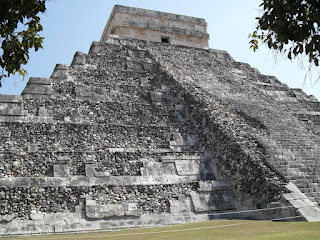 |
| Temple at the top of the pyramid. Notice the shape of a face above the door. |
 |
| Glyphs on the walls represent serpents, a symbol of life. The part that looks like an elephant trunk is actually the nose of the Mayan sun god. |
 |
| This is a closeup of the Mayan version of a wailing wall, where those who died in battle were commemorated by a low relief glyph of a skull. The heads of enemies were placed on stakes above the wall. |
 |
| Observational temple at the top of the ball court. |
 |
| If the Mayan ball game was like basketball, this would be the basket. The ball would be more than 3 pounds, and made of solid rubber - and not the bouncy kind, the really hard kind. |
 |
| The Mayan Observatory. |
 |
| This building is believed to be a palace, but is still undergoing reconstruction. |
 |
| The giant wood beams that supported the ceiling have rotted long ago, causing the ceiling to collapse. It's really interesting the see the remnants of such an architecturally advanced society! |







No comments:
Post a Comment
Hey man, what did thumper's dad say? "If you don't got nuttin nice to say, don't say nothing at all."
I'm not petty, but I'll block you. So be like the fonz. . . be cool.